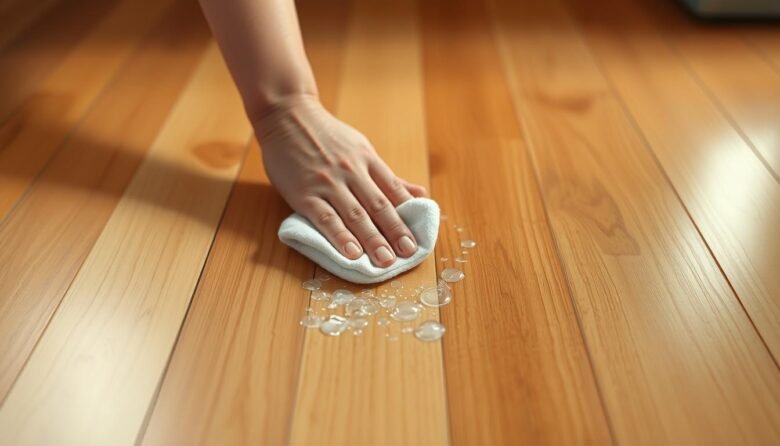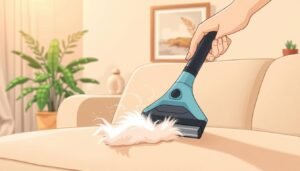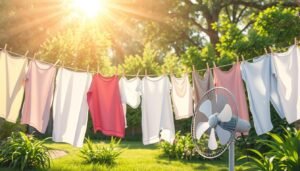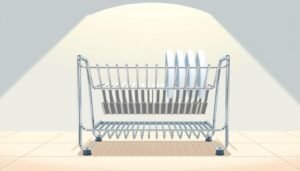Dark streaks and scuffs on your surfaces can ruin the appearance of any room. These common issues affect various materials throughout your home.
Using proper techniques is crucial for effective cleaning. The wrong approach can damage your surfaces. This guide provides tailored solutions for different materials.
Prompt action helps maintain surface integrity. It also prolongs the lifespan of your investment. We cover causes and specific methods for hardwood, laminate, and tile.
Professional tips and preventive measures will keep your spaces looking their best. Real examples like baking soda and microfiber cloths ensure authentic results.
Key Takeaways
- Different flooring materials require specific cleaning approaches
- Proper techniques prevent damage during scuff removal
- Immediate attention to marks helps preserve surface quality
- Household items like baking soda can be effective solutions
- Preventive measures reduce future scuff mark formation
- Always test methods in inconspicuous areas first
- Following manufacturer guidelines ensures optimal care
Understanding Shoe Marks and Their Impact on Different Flooring Types
Those dark streaks on your surfaces come from more than just dirt. They represent a transfer of materials from footwear to your home’s foundation.
Friction between soles and surfaces creates these visible traces. Rubber from sneakers and grime from outdoors are common culprits. This interaction leaves residues that vary by material composition.
What Causes Scuff Marks on Floors
Dragging or rubbing motions generate the marks you see. The process involves physical contact and material transfer. Different soles deposit unique combinations of substances.
Hardwood responds differently than vinyl or laminate. Some materials show scratches more easily. Others might experience discoloration from certain residues.
Why Prompt Stain Removal Matters for Floor Maintenance
Immediate attention prevents permanent damage. Lingering residues can embed themselves deeper over time. This makes later removal more difficult and intensive.
Delayed care risks compromising protective finishes. It can reduce the lifespan of your investment. Proper maintenance preserves both appearance and structural integrity.
Choosing appropriate methods protects your surfaces. Harsh approaches like steel wool damage delicate finishes. Gentle techniques maintain quality while addressing the issue.
Understanding these principles prepares you for effective solutions. The next section explores specific techniques for various materials.
Effective Cleaning Methods for Various Floor Surfaces
Different materials require specific approaches for optimal results. The right technique preserves your investment while eliminating unwanted traces.
Each surface has unique characteristics that demand tailored care. Understanding these differences ensures successful outcomes without damage.
Hardwood Floor Scuff Mark Removal Techniques
Create a baking soda paste with a small amount of water. Apply this mixture using a soft cloth in circular motions.
Gently rub the affected area until the mark disappears. Wipe clean with a damp cloth afterward.
Another effective method involves using a tennis ball. Rub the ball over the scuff for non-abrasive removal.
Avoid steel wool or harsh cleaners that can damage the wood finish. Always test any method in an inconspicuous space first.
Vinyl and Luxury Vinyl Tile (LVT) Cleaning Solutions
Start with a clean eraser for light scuff marks. Apply gentle pressure and rub the affected area.
For tougher marks, mix dish soap with warm water. Use a microfiber cloth to apply this solution.
Stubborn stains may require rubbing alcohol. Dab a cloth with a small amount and test carefully.
Use alcohol sparingly to avoid dulling the surface finish. Rinse thoroughly with clean water afterward.
Laminate Flooring Stain Removal Approaches
Non-gel toothpaste works well on laminate surfaces. Apply a small amount to a damp microfiber cloth.
Gently rub the area using circular motions. Wipe clean with another damp cloth to remove residue.
Avoid abrasive cleaners that can scratch the surface. Always follow manufacturer guidelines for proper care.
This method effectively removes scuff marks without damaging the protective layer.
Tile Flooring (Ceramic or Porcelain) Cleaning Methods
Wet a magic eraser and scrub the marked area. This tool works well on glazed tile surfaces.
For persistent marks, create a baking soda paste. Apply the paste and let it sit briefly before wiping.
Exercise caution around grout lines during cleaning. Test your method on grout first to prevent discoloration.
Rinse thoroughly with clean water after treatment. Dry the surface with a soft towel to prevent water spots.
Concrete Floor Scuff Mark Solutions
Mix dish soap with warm water for basic cleaning. Use a soft-bristle brush to scrub the area.
For tougher scuffs, create a baking soda paste. Apply and let it sit before scrubbing gently.
A magic eraser works effectively on sealed concrete. Always test in an inconspicuous area first.
Rinse thoroughly and allow the surface to dry completely. This prevents any residue from remaining.
Carpeted Floor Rubber Mark Removal
Create a mild detergent solution with warm water. Dampen a cloth with this mixture.
Blot the affected area rather than rubbing. This prevents the mark from spreading further.
Always test your cleaning solution in an hidden area first. Different carpet types react differently to cleaners.
Allow the area to dry completely after treatment. Use fans or open windows to speed drying time.
These tailored methods address specific surface needs effectively. Proper technique ensures successful removal while protecting your investment.
The next section covers professional tips and safety precautions for optimal floor care.
Professional Tips and Safety Precautions for Floor Care
Proper maintenance extends the life of your investment. Smart practices protect surfaces while addressing unwanted traces.
Following expert advice ensures effective results. It also prevents potential damage during the process.
These professional tips cover testing, product selection, and common pitfalls. They apply to all surface types in your home.
Testing Cleaning Methods in Inconspicuous Areas
Always test your chosen method in a hidden spot first. This simple step prevents unexpected damage or discoloration.
Apply a small amount of your solution to an unseen area. Wait a few minutes to observe any adverse reactions.
This approach is particularly important for sensitive materials. Wood and carpet require extra caution during testing.
Never skip this crucial verification step before full application. It ensures your surface remains unharmed.
Choosing the Right Cleaning Products for Your Floor Type
Select products specifically designed for your surface. Different materials demand unique solutions.
Hardwood benefits from pH-neutral cleaners. These preserve the natural finish without causing damage.
Laminate requires non-abrasive solutions. Avoid chemicals that might strip protective layers.
Natural stone surfaces need special attention. Acidic products like vinegar can cause permanent etching.
Always check manufacturer recommendations for approved products. Brands like Crayerase work well for certain applications.
Avoiding Common Floor Cleaning Mistakes
Many people use excessive force during scrubbing. This can scratch surfaces rather than clean them.
Another mistake involves using improper products. Always match your cleaner to your surface type.
Ignoring manufacturer guidelines leads to problems. These instructions provide specific care requirements.
Ensure proper ventilation when using chemical products. Store all cleaners safely away from children and pets.
Follow disposal guidelines for environmental safety. These precautions protect both your home and the planet.
These professional tips safeguard your surfaces during maintenance. They complement the specific methods discussed earlier.
Proper care preserves appearance and extends longevity. The next section covers long-term prevention strategies.
Maintaining Pristine Floors and Preventing Future Scuff Marks
Keeping your surfaces looking their best requires consistent care. A proactive approach saves time and preserves your investment.
Address unwanted traces immediately with gentle methods. This prevents permanent damage to delicate finishes.
Use quality mats at entryways to trap debris. Encourage household members to remove footwear indoors.
Apply protective pads under furniture legs. This prevents dragging motions that cause issues.
Regular sweeping removes abrasive particles. Periodically apply appropriate sealants to maintain protective barriers.
Always follow manufacturer guidelines for optimal results. These practices ensure long-term beauty and value.
Proper maintenance reduces future cleaning needs. Your home will maintain its aesthetic appeal for years.



